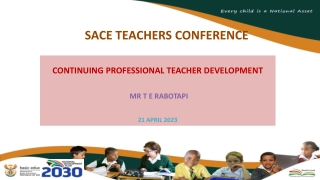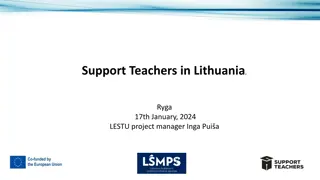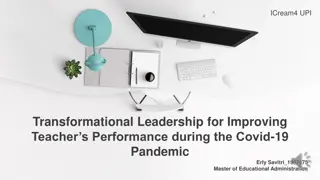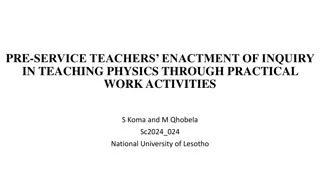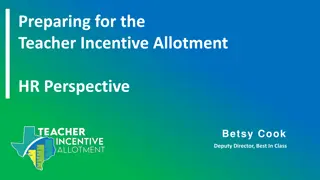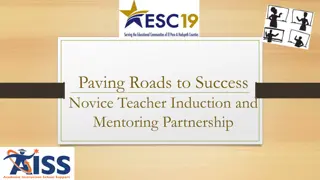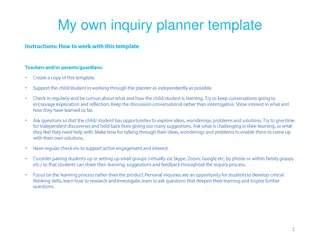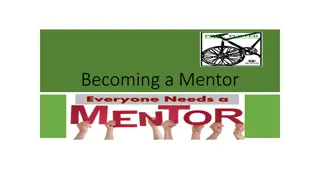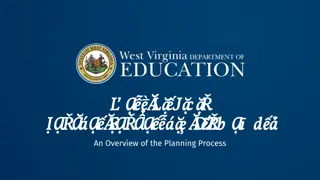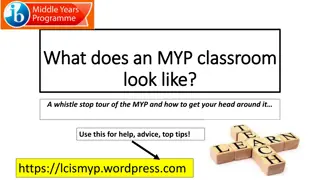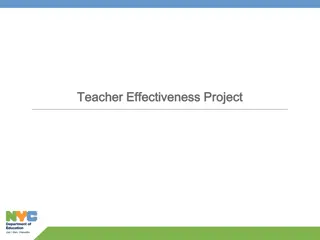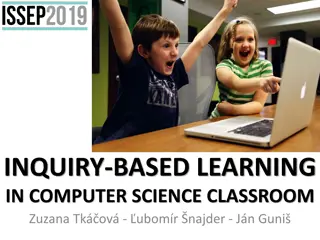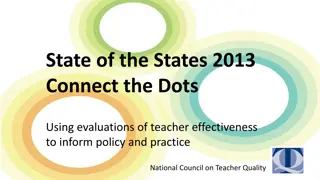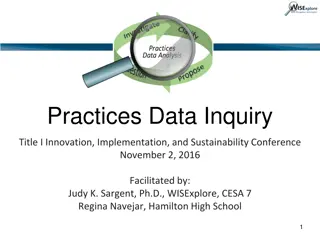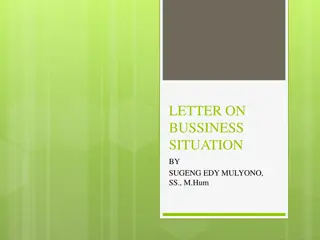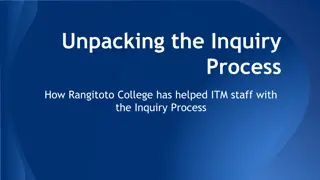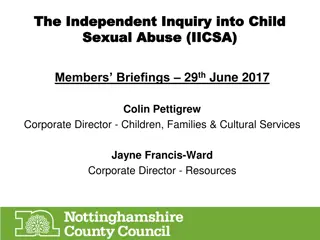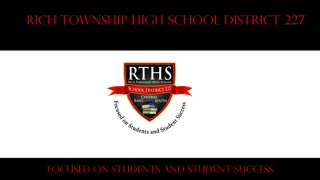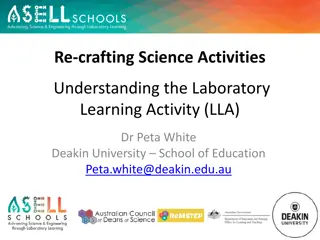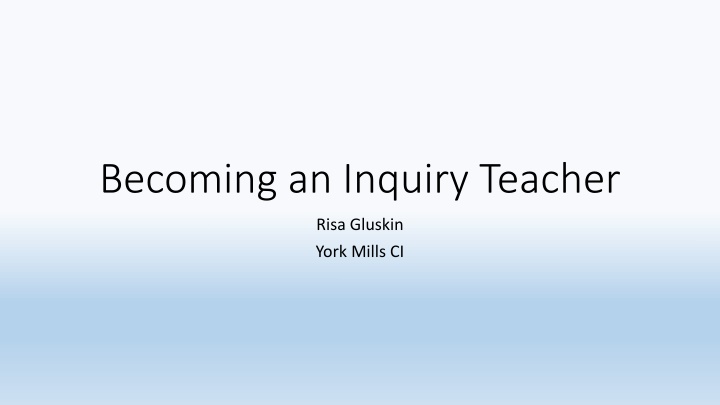
Nurture Critical Thinking and Inquiry Skills in the Classroom
Enhance your teaching approach with inquiry-based strategies to foster critical thinking and student engagement. Explore the integration of Historical Thinking Concepts (HTCs) and develop inquiry skills through well-crafted questions, promoting deep learning over surface memorization.
Download Presentation

Please find below an Image/Link to download the presentation.
The content on the website is provided AS IS for your information and personal use only. It may not be sold, licensed, or shared on other websites without obtaining consent from the author. If you encounter any issues during the download, it is possible that the publisher has removed the file from their server.
You are allowed to download the files provided on this website for personal or commercial use, subject to the condition that they are used lawfully. All files are the property of their respective owners.
The content on the website is provided AS IS for your information and personal use only. It may not be sold, licensed, or shared on other websites without obtaining consent from the author.
E N D
Presentation Transcript
Becoming an Inquiry Teacher Risa Gluskin York Mills CI
Do I want to produce a thinker or a memorizer? Does the atmosphere of my class support this endeavour?
Try an Inquiry (not a historical one) The world seems like a good place to start an inquiry.
HTCs = Historical Thinking Concepts They are the everyday vocabulary of my class From day one of the course They lend themselves naturally to critical thinking and inquiry Therefore, strand A is woven into everything I do: Assessment as and for learning Daily activities Assessment of learning Unit assignments Tests/quizzes Course culminating assignment and exam Technically, design down starts here
HTC Concept Integration Historical Significance Causes and Consequences Continuity and Change (Primary) Evidence Ethical Historical Perspectives Dimensions of History
Inquiry Skills Not Necessarily in Order Formulating questions Gathering and organizing information, evidence, and/or data Interpreting and analysing information, evidence, and/or data Evaluating information, evidence, and/or data and drawing conclusions Communicating findings and/or plans of action
Inquiry Questions Inquiry starts with good questions As Jill Colyer and Jennifer Watt write in IQ: A Practical Guide to Inquiry Based Learning, a good inquiry question is an invitation to think (not recall, summarize, or detail).
Deep vs. Surface Learning Deep Active Critical thinking Reflection Student-centred Surface Passive Memorization Acceptance Teacher-centred
21st Century Classroom 21st 20th Teachers control (managing) Students take initiative (teachers facilitate) Teachers present (yes, this includes our beloved PPTs) Students engage in active learning No computers in the classroom (or cell phones) Tech is a daily part of class life (phones can be put to good use) [socrative] Rows Groups/pods for collaboration, stations
Edugains Says 21stCentury Skills Are Engaging students as partners in their own learning Harnessing the capacity of technology to engage learners and to optimize and amplify student learning and achievement Creating more teacher-student learning partnerships through real world, authentic learning tasks enabled by technology Emphasizing and teaching important higher-order skills such as critical thinking, communication, collaboration, creativity and entrepreneurship Supporting educators in preparing our students for a rapidly changing, technology-driven, globalized world Edugains. About 21st Century Learning in Ontario. 2016. http://www.edugains.ca/newsite/21stCenturyLearning/about_learning_in_ontario.html (Nov. 27, 2016)
Triangulation = 21st Century Ways of Assessing Products E.g., I assess students as they compare lessons learned from decolonization experiences in Algeria, Ghana, India, Kenya Conversations Observations
Less Is More Emphasize why and how things happened rather than what Let go of some of the details Do more with less
Research has found that inquiry-based activities can boost students learning in a wide range of school subjects. However, the effectiveness of inquiry-based learning depends on the guidance provided by teachers. Unguided or minimally-guided inquiry may not work for students who have less previous knowledge or ability in the subject area. When the demands of the learning activities exceed students abilities, their learning is blocked and they may develop misunderstandings about the topic. Therefore, appropriate guidance must be incorporated into students inquiry learning. For example, teachers should guide students to develop a good question for investigation, monitor their inquiry process, and provide guidance when they encounter difficulties. Teachers should give students ongoing feedback and encourage them to constantly assess their own learning. Compared with having the teacher present all of the information, research offers clear evidence that teacher-guided inquiry works in the best interests of students and their learning. Canadian Education Association. Is Inquiry-Based Learning Effective. N.d. http://www.cea-ace.ca/sites/cea- ace.ca/files/cea_facts_on_ed_inquiry-based_learning.pdf (Nov. 26, 2016)
Its not just sitting at a computer filling in worksheets Use assessment as and for along the way to guide, get and give feedback
Research vs. Inquiry Inquiry-based teaching is a profound change from business as usual. Inquiry- based teaching transforms the aims of schools from short- term memorization of facts into disciplined questioning and investigating. (Wolk, 2008, p. 117) Starting research is often the hardest part because there s no guiding question Research Inquiry
Lessons Ive Learned Do Don t Question Cover Accept multiple answers Think there s only one answer Focus on big ideas and documents Focus on memorizing dates Teach kids to ask questions Use computer time for interesting, scaffolded purposes Provide all the answers Just stick the kids on the computer Use worksheets/organizers as tools in the process of inquiry Use worksheets/organizers as ends unto themselves
Who and/or What Makes Historical Change? (HTC = Causes and Consequences) The placement of the X is up to each individual student based on their interpretation of the evidence Individuals X Historical Conditions/ Social Forces Groups
Introductory Unit (CHW3M) Model Inquiry from Day One Teacher-in-a-box (teaches inferencing) Frink s dig (in the shoes of an archaeologist) Paleolithic reindeer carving (introduction to evidence, application of inferencing) Paleolithic-Neolithic categorization activity (deductive reasoning) See http://gluskin.ca/chw3m-world-history/paleolithic-neolithic/
Traditional vs. Inquiry Traditional lesson on Mayan sacrifices Inquiry lesson on Mayan sacrifices Overview History Reading and notes Some kind of application Question and answer worksheet The night before ask students to read (no notes) something of their choice on the internet on Mayan sacrifice Put students in groups Have them share something they learned from their quick research (usually prompts good discussion) Group creates questions on sacrifice Class or group share on ethical concerns relating to sacrifice (HTC = ethical dimension) Have students individually weigh the evidence in a journal entry/reflection
Mayan Bloodletting Mini Inquiry How Maya themselves saw bloodletting (*ethical concerns identified by students): Consensual people agreed to it (*children, orphans, slaves, not nobles) Many children agreed to it because they were brought up in that climate Religiously motivated Pain was seen as something they give for the gods *Less pain for nobles They believed it would lead to good things Important if doom is coming *To keep nobles in power
Weighing the Evidence HTC Journal Entry 1. an unethical practice (ethical concerns are heaviest, even considering their own culture) 2. on the whole it is okay but there are some minor ethical concerns 3. an ethical practice (it was accepted in their society and we don t have major ethical concerns)
Traditional lesson on Athenian democracy Fill in worksheet/organizer with details from textbook Research each contributor to democracy Rank the contributors Inquiry lesson Athenian democracy Establish topic question (To what extent was Athens democratic?) Provide handout with information filled in (less detail than before) Students rank contributions to Athenian democracy and justify their choices using criteria Traditional lesson on Greek women Inquiry lesson on Greek women Take textbook notes Compare to women in Canada and other civs studies Read textbook section Make inferences from primary sources (vases with imagery related to women) Compare inferences to textbook information Apply inferences to primary source document by Aristotle on women End with questions for or about Aristotle s view on women
Ancient Greek Women Discuss what inferences historians could make about Greek women based on 10 objects. Divide your inferences into these three categories: What is known for certain? What is probable? What is unsure (you are guessing)? Attributed to the Amasis Painter: Lekythos. (31.11.10) . Heilbrunn Timeline of Art History. Metropolitan Museum of Art. 2000-. http://metmuseum.org/toah/works-of-art/31.11.10 (July 10, 2012).
1876 2015 Timeline: Gaining Rights for Aboriginal Canadians For each event/date, students identify which of the 6 themes it relates to: 1. Significance results in change 2. Agency improvements made by individuals, groups or organizations 3. Continuity more of the same 4. Perspectives/views 5. Health of the relationship between people in Canada 6. Identity/citizenship Then they choose the best example (most fitting) for each theme and explain the connection. This activity would be better with a guiding question, such as What would be the most appropriate way to describe the process of gaining rights for Aboriginal Canadians? Need follow-up questions
Helpful Tools A course question Eg., CHY4U: how did we get here? Unit questions What were they thinking? What is worth fighting for? How was the world reshaped? Are we any better? Frequent feedback (from teacher, peers, self) Google classroom or a journal 3 part-lesson format Images / maps as minds on Sitting in groups/pods Using white boards or chart paper
Fears Addressed Losing control Neat little rows and quiet students make me nervous = disengaged Not having structure Increase students freedom (more in grade 12 than grade 10) Noise It s productive participation Not knowing the answer You don t have to you all explore together and multiple answers are often possible (avoids a lot of multiple choice recall)
My Personal Challenges Getting kids to develop good inquiry questions Minimize or get rid of multiple choice questions on tests Have all open book tests Forces me to ask really open-ended questions that require thinking Forces students to take good notes and invest in the unit because they can t use their textbook Students have felt engaged by the questions In the future I d like to try a test-less semester Group work tests (new primary source given to a group to examine for 10 minutes; individual follow-up [test or assessment] then occurs).
Next Step Go forth and stand on the side of your class!

